What sort of work do you do on the spacesuit research team?
As a member of the spacesuit research team, I perform technical investigations and draw up research plans, coordinate with people in and outside of JAXA, as well as scheduling, budgeting and other such administrative duties. In addition to that, I work in publicity, informing the general public about our spacesuit research.
Can you briefly describe the configuration of the American spacesuit?
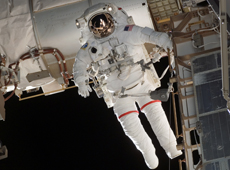
U.S. Extravehicular Mobility Unit (courtesy: NASA)
I think the most distinctive thing about it is the many materials it uses. The main parts of the spacesuit have 14 layers of flexible materials, including fabric made of heat-resistant, highly stretchable super-fiber, and aluminum-metallized film that’s also used as insulation for satellites. In addition, the joints, such as the shoulders and lower back, have aluminum bearings, and the torso section has a hard material called glass fiber reinforced plastic, or GFRP. It might be easier to understand what the torso section is if you imagine kendo armor.
We imagine a “suit” as being soft, and the American spacesuit may look like it’s made of white cloth, but many of its components are made of hard materials. And the Russian spacesuit used on the International Space Station has the same distinctive characteristics as the American spacesuit.
What about the liquid cooling and ventilation garment?
The liquid cooling and ventilation garment is the innermost layer of the spacesuit, right on the astronaut’s skin. Because the spacesuit is heavily insulated and hermetically sealed, it traps body heat. So the astronaut’s body needs to be cooled. The liquid cooling and ventilation garment is roughly 90 meters of tubing stretched over the top of a thin two-piece undergarment. Coolant circulates through the tube and removes heat from the body’s surface. The coolant is supplied by the life support system on the back of the spacesuit.
What else does the life support system have?
There’s an oxygen tank for breathing, a device to absorb carbon dioxide, a device to regulate pressure inside the spacesuit, a communications device and battery, a computer and more.
That’s a lot of things packed into a small box!
Yes. We call the spacesuit a mini spaceship. This one piece of equipment can allow a person to survive in space for a certain amount of time.
What are the differences between the American and Russian spacesuits?
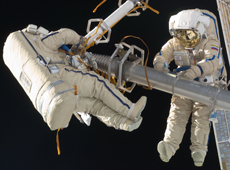
Russian Orlan spacesuit (courtesy: NASA)
The biggest difference is the air pressure. The American spacesuit operates at 0.3 atmospheres and the Russian one at 0.4 atmospheres. The air pressure inside the spacesuit is directly proportionate to the time required for prebreathe protocol prior to a spacewalk and how easy it is to move during the spacewalk.
What is prebreathe protocol?
Prebreathe is the extraction of nitrogen from the body of an astronaut on the ISS – where the air pressure is 1 atmosphere – prior to a spacewalk. to a spacewalk. This is done to prevent decompression sickness during the spacewalk, when the astronaut wears a spacesuit with low air pressure (0.3 or 0.4 atmospheres). If you go scuba diving, you have to be careful about decompression sickness when you come up too fast, so I think it’s similar to that. Currently, prebreathe takes several hours, but the smaller the difference between the air pressure inside the spacesuit and on the ISS, the less time is required.
In that case, wouldn’t it be better if the air pressure in the spacesuit were higher?
The problem is, the higher the air pressure in the spacesuit, the more it swells in the vacuum of space, which makes it difficult to move. Swelling in the gloves in particular makes it very hard to move the fingers – it’s like wearing layers and layers of thick winter mittens. And during a spacewalk, astronauts need to have a strong grip.
What do you think would be the best improvement we could make to today’s spacesuit?
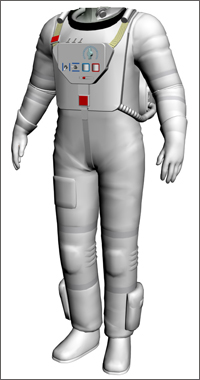
JAXA’s next-generation spacesuit (artist’s rendition)
I think the biggest improvement we should make is reducing the time required for prebreathe before a spacewalk. That, and the aluminum and other hard materials used for the joints and torso section.
What improvements is JAXA working on in the spacesuit it’s developing?
JAXA’s next-generation advanced spacesuit will have an internal air pressure of 0.58 atmospheres, which would eliminate the need for prebreathe before spacewalks. That’s nearly twice the pressure in the American spacesuit, so that’s amazingly high. Eliminating prebreathe would save precious work time, and it would also mean the suit could be used to escape the spaceship in case of an emergency.
I see. Those are big advantages.
In addition, the major goal of our research is to make the suit out of fabric only (excluding the life support system, helmet, etc., of course). We’ve set our target weight for the entire spacesuit at 90 kilograms or less. (The American spacesuit weight about 120 kilograms.) A spacesuit made of fabric would be significantly lighter, and would need much less storage space because it would be foldable and compact. Also, a spacesuit made of mostly soft fabric could be used during launch and re-entry, to protect against shocks and vibration. Right now astronauts have two spacesuits – a pressurized suit for launch and re-entry, and an extravehicular suit worn in space. With our new suit, they would need just one.
Sounds like making it out of fabric would be a huge selling point.
Yes. But making a spacesuit is a new challenge for us. JAXA has no experience or expertise with things like fibers, or clothing design and manufacture, so it’s been very difficult for us. Because of that, we are keeping our eyes open, and pointing our antennae, so to speak, at fields outside space. We collect information through newspapers, the internet and elsewhere on new materials, techniques and products appearing around the world. When we find something we think might be useful, we contact the manufacturer and investigate whether we can use it in a spacesuit.
Japan apparently has some of the best fiber technology, clothing design and manufacturing technology in the world, so if we could combine them effectively, I think we can definitely make a spacesuit that’s even better than the American and Russian ones.
I’m looking forward to seeing a spacesuit made in Japan!
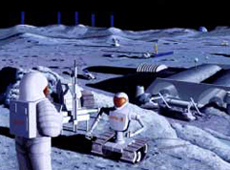
Artist’s rendition of manned lunar exploration
In our current research, we are proceeding through the PDCA (plan–do–check–adjust) cycle, in which we lay out the problems relating to our spacesuit, draw up a research plan, then perform research according to the plan while at the same time identifying new issues, which are reflected in our next research plan. This is how I would like us to work: attacking one problem at a time, accumulating skill and expertise, and proceeding one step at a time towards creating a Japanese-made spacesuit.
What is the ultimate goal you’re aiming for?
Our ultimate goal is a spacesuit that can be used on the Moon. We’ve already made prototypes of a new liquid cooling and ventilation garment and pressure restraint garment, so if we continue to work hard, I think we may be able to show people something that would be immediately recognizable as a spacesuit.
The Moon?!
Yes. We envision our spacesuit being used on the Moon, in anticipation of the next stage of manned space exploration after the ISS.
There are around 200 astronauts in the world who have performed a spacewalk, but only 12 who have walked on the Moon. These 12 were Apollo program astronauts, so the most recent “moonwalk” was about 40 years ago. Unlike a spacewalk on the ISS, on the Moon you have to move the lower body to walk, run and jump. You also have to deal with fine Moon dust (known as regolith) and sharp rocks. There are still many problems to work out.
But I believe it is very important for Japan to acquire technology that other countries do not have, so that when, in the future, there is an international plan for manned lunar exploration, we can take the initiative. This is why we are tackling the more challenging problems.
Did you watch astronaut Akihiko Hoshide’s spacewalks? How did they make you feel?
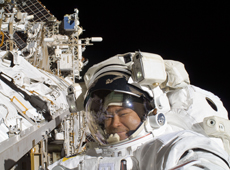
Astronaut Akihiko Hoshide conducting a spacewalk (courtesy: JAXA/NASA)
I watched in real time from the Tsukuba control room. Different tasks were assigned for each spacewalk, so I watched from an engineering standpoint, as in, “Where will he go during this spacewalk and how will he get there? What tools will he use? What kind of work will he do?”
Meanwhile, I was very aware that the spacesuit was the only thing truly protecting him. Hoshide had a video camera attached to the top of his helmet, so I could see video from his perspective on a monitor in the control room, and I could also hear his voice over the radio. Every now and then the monitor showed the deep black of space, but I could still hear Hoshide’s breathing. I felt the illusion that I was actually doing the spacewalk myself. Of course it’s obvious if you think about it, but I was amazed: “We really can survive in a spacesuit!” It reaffirmed to me again that the spacesuit is an amazing piece of technology.
It really is a mini spaceship. Have you thought about how this research may be used in the future?
Before I knew much about spacewalks, I thought you just moved slowly, using your whole body to float gently through the weightlessness of space. But it was refreshing to learn that a lot of it involves delicate work with the hands. The astronaut may have to remove metal dust trapped inside a hole, or push an electric screwdriver’s switch over and over to change the setting. I hope we can build a spacesuit that allows both full-body movement and delicate finger movements.
What do you find interesting about researching spacesuits?
A spacesuit is like a small spaceship, and operating it involves handling machinery that’s as close to the human body as can be. Before I joined the spacesuit research team, I did environmental testing on satellites. Ultimately, the big difference between a spacesuit and a satellite is that the spacesuit has a person inside. But as with a satellite, when you make a spacesuit, you go through the steps of determining the specs, drawing up a design, making parts, and then assembly and testing. But with a spacesuit you can’t forget to ask, “Will this be comfortable for a person to wear? Will it be easy to use?” These questions are difficult to quantify, so there’s no single right answer. Instead, I think that the makers of a spacesuit must have a solid design concept. Going after unquantifiable aspects can be incredibly frustrating, but it’s also interesting.
What do you imagine would be the ultimate spacesuit?
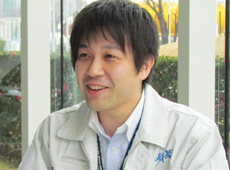
To put it simply, a spacesuit sold in stores. When you’re making a prototype spacesuit, the level of perfection in clothing sold in stores really hits home. They’re stylish, and they balance functionality, performance, durability and cost. And you don’t need a special manual to wear them, wash them or put them in a closet.
In the near future, when anyone can go to space, it would be a spacesuit that anyone, young or old, male or female, can buy and wear, not an exclusive piece of equipment only for astronauts with special training. And right before a spacewalk, you could just throw it on, tighten the fastener, shout “No air leaks! OK!” and fly into outer space in a flash. That’s the world I imagine. (Laughs.)
What’s your outlook for the future.
We exhibited our spacesuit during a special open house at the Tsukuba Space Center. The visitors gave us warm words of encouragement, saying things like, “We want Japan to use its special characteristics to create a spacesuit.” I want to do my best to fulfill their desire. And personally, I’d like to become a project manager for a spacesuit development project and surprise the whole world with our result.
Engineer, JEM Mission Operations and Integration Center, Human Space Systems and Utilization Mission Directorate, JAXA
Yoshio Wada joined JAXA in 2008. He has investigated testing methods, developed equipment, supported projects, and performed other duties involving mechanical environment testing at the Environmental Test Technology Center. Mr. Wada has worked in the Flight Crew Operations and Technology Department and elsewhere in JAXA, and was assigned to his current position in April 2013.
Go for Space!
A Mini Spaceship for One
Building a Good-Looking Spacesuit
Building a Better Spacesuit with Medicine
